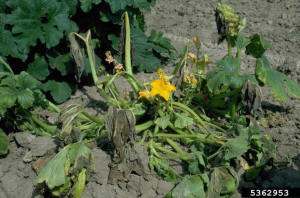|
 It is often possible to see streaking of the wood, or a dark
ring around the center portion of the branch or trunk with
verticillium wilt, but a lab analysis is needed for definite
confirmation. There are no cures for any of these diseases at
this time, but pruning out infected limbs is practiced. Severely
infected trees should be removed to help prevent transfer from
root grafting. The list of trees affected by verticillium is
very large, but good quality maples are very susceptible. There
have been many affected trees again this year, including maples
and ashes, as well as shrubs such as smoke bush and viburnam.
The only treatment is to water and fertilize to try and get new
growth, and new water and food carrying tissues. It is often possible to see streaking of the wood, or a dark
ring around the center portion of the branch or trunk with
verticillium wilt, but a lab analysis is needed for definite
confirmation. There are no cures for any of these diseases at
this time, but pruning out infected limbs is practiced. Severely
infected trees should be removed to help prevent transfer from
root grafting. The list of trees affected by verticillium is
very large, but good quality maples are very susceptible. There
have been many affected trees again this year, including maples
and ashes, as well as shrubs such as smoke bush and viburnam.
The only treatment is to water and fertilize to try and get new
growth, and new water and food carrying tissues.
The years of stressful weather just keep piling on. Even last
year was stressful with an overabundance of water early,
followed by the extremely dry period later. Just like us, trees
like moderate weather. When we have extreme heat and cold, and
no moisture or a flood, the trees are stressed. This stress
makes them more susceptible to things that are always in the
environment. Try to even out some of the extremes by watering
when it is dry, fertilizing when you do the lawn (or just
fertilize the tree), and mulching to even out the soil
temperature in the root area. Remember that many diseases can be
passed with pruning equipment, so disinfect your equipment
between cuts.

The following is a recommendation from the University of
Illinois Plant Clinic: “Once a plant has succumbed to
Verticillium wilt, we recommend replanting that area with
non-susceptible species. Apple, pear, crabapple, gingko,
sycamore, walnut, willow, rhododendron and azalea, and oaks in
the white oak group are some woody plants that are considered
non-susceptible to Verticillium wilt. In addition, all conifers
are considered resistant to Verticillium wilt.”
[to top of second column] |


Wilt of Vining Crops
With the growing season entering the home stretch for vining
crops such as squash, pumpkins, cucumbers, and melons, there are
few things worse than having your vines wilt suddenly. I’ve
noticed the population of the striped cucumber beetles have
exploded in the past few weeks. These beetles can be green,
black and yellow striped, or black and yellow spotted. The
importance of the beetles is not that they eat small holes in
the leaves, but that the beetles can transmit a bacterial wilt
to the plants as they eat. The first thing you see is you have a
plant that suddenly wilts on various runners, or the entire
plant. The best means of controlling this disease is a good
beetle control program. Current homeowner recommendations would
include these products with the days to harvest restrictions in
parenthesis: carbaryl (0), bifenthrin (3 days), or rotenone (1
day).
[By JOHN FULTON, COUNTY EXTENSION
DIRECTOR SERVING LOGAN, MENARD, AND SANGAMON COUNTIES] |